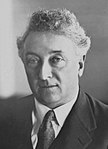Australian general election, 1934
|
|
|||||||||||||||||||||||||||||||||||||||||
|
|||||||||||||||||||||||||||||||||||||||||
|
All 74 seats of the Australian House of Representatives 38 seats were needed for a majority in the House 18 (of the 36) seats of the Australian Senate |
|||||||||||||||||||||||||||||||||||||||||
|---|---|---|---|---|---|---|---|---|---|---|---|---|---|---|---|---|---|---|---|---|---|---|---|---|---|---|---|---|---|---|---|---|---|---|---|---|---|---|---|---|---|
|
|||||||||||||||||||||||||||||||||||||||||
|
|||||||||||||||||||||||||||||||||||||||||
Joseph Lyons
UAP/Country coalition
Federal elections were held in Australia on 15 September 1934. All 74 seats in the House of Representatives, and 18 of the 36 seats in the Senate were up for election. The incumbent United Australia Party led by Prime Minister of Australia Joseph Lyons with coalition partner the Country Party led by Earle Page defeated the opposition Australian Labor Party led by James Scullin. Labor's share of the primary vote fell to an even lower number than in the 1931 election due to the Lang Labor split, but it was able to pick up an extra four seats on preferences and therefore improve on its position. The Coalition suffered an eight-seat swing, forcing Lyons to take the Country Party into his government (the UAP had governed alone in the previous term).
The member for Northern Territory, Adair Blain (Independent), had voting rights only for issues affecting the Territory, and so is not included in this table.
...
Wikipedia



